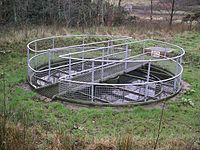
Photo from wikipedia
Types of microbial aggregates have essential effects on bacterial communities' characteristics, thus affecting the pollutants removal. An up-flow biofilm reactor was used to study the different performances of S2-/ NO2-… Click to show full abstract
Types of microbial aggregates have essential effects on bacterial communities' characteristics, thus affecting the pollutants removal. An up-flow biofilm reactor was used to study the different performances of S2-/ NO2- removal and functional genes in suspended sludge and biofilms. The metabolic pathways of sulfurous and nitrogenous pollutants in the desulfurization-denitrification process were proposed. The results showed that S0 formation dominated the reactor with a high S2- concentration. Autotrophic Sulfurovum responsible for S2-/S0 oxidation was the only dominant bacteria in suspended sludge. Heterotrophic Desulfocapsa responsible for SO42- reduction coexisted with Sulfurovum and dominated in biofilms. S2- oxidation to S0 was catalyzed via fccA/B and sqr genes in suspended sludge. S32-/S0 oxidation to SO42- was catalyzed via dsrA/B gene in biofilms. SO42- and NO2- were removed via the dissimilatory sulfate reduction and denitrification pathway, respectively. This work provides a fundamental and practical basis for optimizing suspended sludge/biofilm systems for S2-/ NO2- removal.
Journal Title: Bioresource technology
Year Published: 2021
Link to full text (if available)
Share on Social Media: Sign Up to like & get
recommendations!